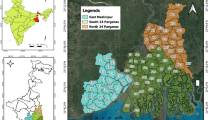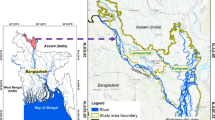Abstract
As a basic property of cloud, accurate identification of cloud type is useful in forecasting the evolution of landfalling typhoons. Millimeter-wave cloud radar is an important means of identifying cloud type. Here, we develop a fuzzy logic algorithm that depends on radar range-height-indicator (RHI) data and takes into account the fundamental physical features of different cloud types. The algorithm is applied to a ground-based Ka-band millimeter-wave cloud radar. The input parameters of the algorithm include average reflectivity factor intensity, ellipse long axis orientation, cloud base height, cloud thickness, presence/absence of precipitation, ratio of horizontal extent to vertical extent, maximum echo intensity, and standard variance of intensities. The identified cloud types are stratus (St), stratocumulus (Sc), cumulus (Cu), cumulonimbus (Cb), nimbostratus (Ns), altostratus (As), altocumulus (Ac) and high cloud. The cloud types identified using the algorithm are in good agreement with those identified by a human observer. As a case study, the algorithm was applied to typhoon Khanun (1720), which made landfall in south-eastern China in October 2017. Sequential identification results from the algorithm clearly reflected changes in cloud type and provided indicative information for forecasting of the typhoon.
Similar content being viewed by others
References
Chu X, Geerts B, Xue L, Pokharel B (2017). A case study of cloud radar observations and large-eddy simulations of a shallow stratiform orographic cloud, and the impact of Glaciogenic Seeding. J Appl Meteorol Climatol, 56(5): 1285–1304
Delgadillo R, Voss K J, Zuidema P (2018). Characteristics of optically thin coastal florida cumuli derived from surface-based lidar measurements. J Geophys Res D Atmospheres, 123(18): 10,591–10,605
Han L, Fu S, Zhao L, Zheng Y, Wang H, Lin Y (2009). 3D convective storm identification, tracking, and forecasting—an enhanced TITAN algorithm. J Atmos Ocean Technol, 26(4): 719–732
Jet Propulsion Laboratory (2012). Level 2 Combined Radar and Lidar Cloud Scenario Classification Product Process Description and Interface Control Document
Kollias P, Clothiaux E E, Miller M A, Albrecht B A, Stephens G L, Ackerman T P (2007). Millimeter-wavelength radars: new frontier in atmospheric cloud and precipitation research. Bull Am Meteorol Soc, 88(10): 1608–1624
Kumar A, Singh N, Singh A (2019). Observations on the distribution of clouds over northern India using joint CloudSat and CALIPSO measurements. Remote Sens Lett, 10(6): 590–597
Küchler N, Kneifel S, Löhnert U, Kollias P, Czekala H, Rose T (2017). A W-Band radar-radiometer system for accurate and continuous monitoring of clouds and precipitation. J Atmos Ocean Technol, 34 (11): 2375–2392
Li X, Zheng X, Zhang D, Zhang W, Wang F, Deng Y, Zhu W (2018). Clouds over east asia observed with collocated cloudSat and CALIPSO measurements: occurrence and macrophysical properties. atmosphere, 9(5): 168
Liu H, Chandrasekar V (2000). Classification of hydrometeors based on polarimetric radar measurements: development of fuzzy logic and neuro-fuzzy systems, and in situ verification. J Atmos Ocean Technol, 17(2): 140–164
Rémillard J, Fridlind A M, Ackerman A S, Tselioudis G, Kollias P, Mechem D B, Chandler H E, Luke E, Wood R, Witte MK, Chuang P Y, Ayers J K (2017). Use of cloud radar Doppler spectra to evaluate stratocumulus drizzle size distributions in large-eddy simulations with size-resolved microphysics. J Appl Meteorol Climatol, 56(12): 3263–3283
Sassen K, Wang Z (2008). Classifying clouds around the globe with the CloudSat radar: 1-year of results. Geo Res Lett, 35: L04805
Stephens G L, Vane D J, Boain R J, Mace G G, Sassen K, Wang Z, Illingworth A J, O’connor E J, Rossow WB, Durden S L, Miller S D, Austin R T, Benedetti A, Mitrescu C (2002). The cloudsat mission and the A-train. Bull Am Meteorol Soc, 83(12): 1771–1790
Wang Z, Sassen K (2001). Cloud type and macrophysical property retrieval using multiple remote sensors. J Appl Meteorol, 40(10): 1665–1682
Wang Z, Wang Z, Cao X, Mao J, Tao F, Hu S (2018). Cloud-base height derived from a ground-based infrared sensor and a comparison with a collocated cloud radar. J Atmos Ocean Technol, 35(4): 689–704
World Meteorological Organization (2017). “Observation” of Clouds Chap. 15.1 in Guide to Meteorological Instruments and Methods of Observation (WMO-No.8)
Sokol Z, Minářová J, Novák P (2018). Classification of hydrometeors using measurements of the ka-band cloud radar installed at the Milešovka Mountain (Central Europe). Remote Sens, 10(11): 1674
Acknowledgements
This work was supported by the National Natural Science Foundation of China (Grant No. 41675029), the National Basic Research Program of China (No. 2013CB430102).
Author information
Authors and Affiliations
Corresponding author
Rights and permissions
About this article
Cite this article
Cheng, Z., Wei, M., Zhu, Y. et al. Cloud type identification for a landfalling typhoon based on millimeter-wave radar range-height-indicator data. Front. Earth Sci. 13, 829–835 (2019). https://doi.org/10.1007/s11707-019-0771-y
Received:
Accepted:
Published:
Issue Date:
DOI: https://doi.org/10.1007/s11707-019-0771-y




